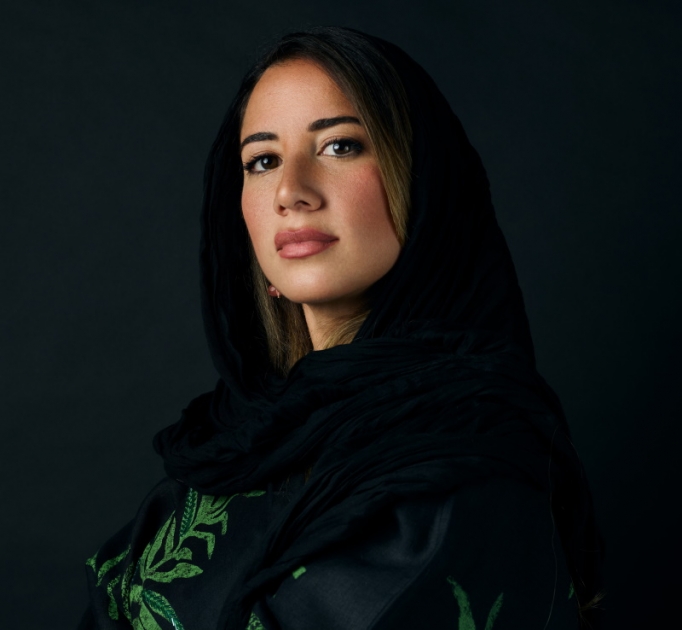
Reimagining Jeddah’s Western Hajj Terminal through Art
The Western Hajj Terminal at King Abdulaziz Airport in Jeddah is no ordinary airport terminal. Designed by Skidmore, Owings & Merrill and a winner of the 1983 Aga Khan Award, it became a port of entry and junction point for hundreds of thousands of Muslim pilgrims from around the world on their way to Awwal Bait – the First House of Allah, the Holy Kaaba in Mecca, a building at the centre of Islam’s most famous mosque. When the terminal opened, it had the world’s largest cable-stayed, fabric-roofed construction; as it was made on an unprecedented scale, the tensile structure made use of newly developed fabric as a permanent structural element instead of the cable-supported in two directions technique, making it a first-of-sorts in airport design.
Today, the Islamic Arts Biennale re-imagines this pioneering structure as a cultural space. The architectural concept of the design is based on a volumetric abstraction inspired by the module of the existing tent canopy structures and the traditional courtyard houses of the past. Whilst the design intertwines with the current Western Hajj Terminal design, the Biennale complex expresses its independence in its visual identity. Instead of competing with the canopies present, the complex complements them by adopting the current grid, breaking it down and using it as the basis of a new expression. The result is that the cluster of volumes resembles fragments escaping an ordered grid, transforming an urban space into an inspiring cultural venue.
.jpg)
Says Aya Al-Bakree, CEO, Diriyah Biennale Foundation, “The Western Hajj Terminal and the city of Jeddah are as integral to the exhibition as the works of art and artifacts displayed. Evoking memory and emotion, the Western Hajj Terminal and Jeddah have symbolized ports of entry to millions of pilgrims on their way to Mecca, with Jeddah representing a junction point between cultures, where the exchange of goods and ideas has taken place for centuries. Permanently transforming an urban space into a cultural one is one of our greatest achievements at Diriyah Biennale Foundation, and we are certain that doing so will continue to enrich the art ecosystem in the city for years to come.”
The Islamic Arts Biennale acts as a platform to mirror the very experience of Hajjis from around the world, by reflecting on the diversity of the Muslim experience [NA1] through a constellation of 60+ artists from over 20 countries, whose work will complement around 200 loans of artefacts from local and international institutions. Themed Awwal Bait (“the First House”), the event interweaves commissioned works and never-exhibited-before historical artefacts that convey a holistic perspective of the Islamic arts, delivered through a unique sensorial experience aimed at heightening consciousness, and inspiring pause and reflection on the rituals that guide people individually, and that creates a sense of belonging collectively.
'The unique visitor experience, spread over 12,000 sqm of exhibition space, will include an evocative journey through five galleries and the grand canopies. The Biennale will provide two main areas for exhibiting artworks and artefacts, the first being a linear sequence of galleries whose spaces, ceiling heights and lighting will be modulated to enhance the visitor’s cognitive and emotional experience, and the second part consisting of two pavilions, Mecca and Medina, and an outdoor area under the canopy of the Western Hajj Terminal, for display of artworks and art installations.
Firas Hnoosh, Architectural Advisor to the Diriyah Biennale Foundation says: “The filtered sunlight seeping through the tent structures of the Western Hajj Terminal, long vistas and views of sky and desert will undoubtedly create an inimitable experience from the indoor galleries of the first section of the Biennale. This combined with two standalone pavilions of Mecca and Medina, a curated selection of food and beverage outlets, a cinema and theatre, library, gift- and bookshops, workshop spaces for the arts and crafts, indoor and outdoor children’s play areas and VIP lounge, is intended to offer an inclusive, wholesome, and meditative experience for all visiting this landmark Biennale.”
Inspired by Jeddah’s heritage as a port of connection, the extraordinary venue is also a nod to the city’s profound cultural heritage and its current place as an art hub. One of the first exhibitions in the Kingdom, hosted in 1968, showcased the work of two female artists, Safeya Binzagr and Mounira Mosly at Jeddah’s Dar-Al-Tarbia Al-Hadetha school. The late Mayor of Jeddah, Mohammed Said Farsi, too, also beautified the Red Sea port city in the 1970s with over 400 sculptures by esteemed artists including Aref El Rayess, Henry Moore, Alexander Calder and Victor Vasarely, of which many were recently restored and placed in a public park. With culture being an integral part of Vision 2030, Saudi Arabia is indeed encountering unprecedented transformation with cultural and artistic exchange becoming essential to contributing to the country’s growth and development.
According to Dr. Saad Alrashid, a leading Saudi scholar and archaeologist, “Saudi Arabia is going through an incredible transformation. Our culture is a rich one that has been shaped by its Islamic heritage and its historical position as an ancient trade centre. The resurgence of the country as an art powerhouse inspired by indigenous methods and practices, is testimony to the cultural wealth of our past and indicative of our inspiring future.”
The theme logo for ‘Awwal Bait’ was designed by graphic designer, Tarek Atrissi invoking the reverence and symbolic unity evoked by Muslims of all backgrounds when confronted by the Kaaba in Mecca, and underscores the importance of the unique geographic location of this Biennale.
Today, the Diriyah Biennale Foundation, established by the Ministry of Culture, has a vital role to play in nurturing this creative expression, instilling an appreciation for arts and culture and providing a platform for discovering and connecting to Saudi Arabia’s burgeoning cultural scene.



























